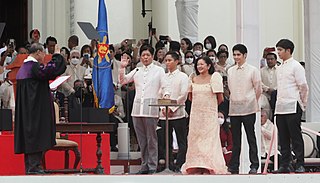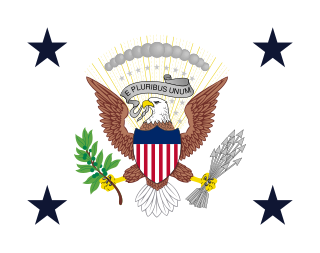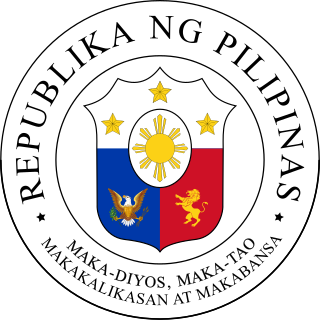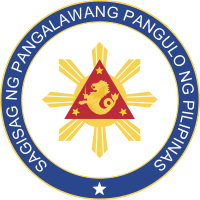
The coat of arms of the Philippines features the eight-rayed sun of the Philippines with each ray representing the eight provinces which were placed under martial law by Governor-General Ramón Blanco Sr. during the Philippine Revolution, and the three five-pointed stars representing the three major island groups of Luzon, the Visayas, and Mindanao.

The national flag of the Philippines is a horizontal bicolor flag with equal bands of royal blue and crimson red, with a white, equilateral chevron at the hoist. In the center of the triangle is a golden-yellow sun with eight primary rays, to represent the original eight provinces that rebelled against the Spanish during the 1896 Philippine Revolution. At each vertex of the triangle is a five-pointed, golden-yellow star, each of which representing one of the country's three main island groups—Luzon, Visayas, and Mindanao. The white triangle at the hoist represents liberty, equality, and fraternity. A unique feature of this flag is its usage to indicate a state of war if it is displayed with the red side on top, which is effectively achieved by flipping the flag upside-down.

The president of the Philippines is the head of state, head of government and chief executive of the Philippines. The president leads the executive branch of the Philippine government and is the commander-in-chief of the Armed Forces of the Philippines.

The seal of the president of the United States is used to mark correspondence from the president of the United States to the U.S. Congress, and is also used as a symbol of the presidency itself. The central design, based on the Great Seal of the United States, is the official coat of arms of the U.S. presidency and also appears on the presidential flag.

The seal of the president of the Philippines is a symbol used to represent the history and dignity of the president of the Philippines. Its original form was designed by Captain Galo B. Ocampo, secretary of the Philippine Heraldry Committee, and patterned after the seal of the president of the United States. It was first used by President Manuel Roxas in 1947.

The Vice President of the Philippines is the second-highest official in the executive branch of the Philippine government and is the first in the presidential line of succession. The vice president is directly elected by the citizens of the Philippines and is one of only two nationally elected executive officials, the other being the president.

The president of the Senate of the Philippines, commonly referred to as the Senate president, is the presiding officer and the highest-ranking official of the Senate of the Philippines, and third highest and most powerful official in the government of the Philippines. They are elected by the entire body to be their leader. The Senate president is second in the line of succession to the presidency, behind only the vice president and ahead of the speaker of the House of Representatives.

The inauguration of the president of the Republic of the Philippines is a ceremony marking the commencement of the six-year term of a president of the Philippines, who is both head of state and head of government. The inauguration is performed on June 30, as mandated by the 1987 Constitution. Under the older 1935 Constitution, the date was December 30, which is also Rizal Day; the last inauguration held on the older date was Ferdinand Marcos' second one on December 30, 1969. The most recent public presidential inauguration ceremony was that of President Bongbong Marcos, who began his six-year term in office on Thursday, June 30, 2022.

The flag of the president of the United States consists of the presidential coat of arms on a dark blue background. While having the same design as the presidential seal since 1945, the flag has a separate history, and the designs on the flag and seal have at different times influenced each other. The flag is often displayed by the president in official photos, or flown next to the casket of a former president in official funeral processions, and flown on the president's motorcade. The flag is not flown at half-staff since there is always an incumbent president in office. The current flag is defined in Executive Order 10860:
The Color and Flag of the President of the United States shall consist of a dark blue rectangular background of sizes and proportions to conform to military and naval custom, on which shall appear the Coat of Arms of the President in proper colors. The proportions of the elements of the Coat of Arms shall be in direct relation to the hoist, and the fly shall vary according to the customs of the military and naval services.

The seal of the vice president of the United States is used to mark correspondence from the U.S. vice president to other members of government, and is also used as a symbol of the vice presidency. The central design, directly based on the seal of the president of the United States, is the official coat of arms of the U.S. vice presidency and also appears on the vice presidential flag.

The flag of the vice president of the United States consists of the U.S. vice presidential coat of arms on a white background, with four dark blue stars in the corners. A version of the flag is kept in the vice president's office, is sometimes displayed by the vice president in official photos, and is flown on the vice president's motorcade.

The flag of the president of the Philippines or the presidential standard of the Philippines consists of the presidential coat of arms on a blue background. While having the same design as the presidential seal since 1947, the flag has a separate history, and the designs on the flag and seal have at different times influenced each other.

The Philippine five hundred-peso note (₱500) is a denomination of Philippine currency. President Corazon Aquino and her husband, Senator Benigno Aquino Jr. are currently featured on the front side of the note, while the Puerto Princesa Subterranean River National Park and the blue-naped parrot are featured on the reverse side.
The Ang Bagong Lipunan Series is the name used to refer to Philippine banknotes and coins issued by the Central Bank of the Philippines from 1973 to 1985. It was succeeded by the New Design series of banknotes. The lowest denomination of the series is 2-piso and the highest is 100-piso.
The Pilipino Series banknotes is the name used to refer to Philippine banknotes and coins issued by the Central Bank of the Philippines from 1969 to 1973, during the term of President Ferdinand Marcos. It was succeeded by the Ang Bagong Lipunan Series of banknotes, to which it shared a similar design. The lowest denomination of the series is 1-piso and the highest is 100-piso.

The inauguration of Fidel V. Ramos as the twelfth president of the Philippines took place on Tuesday, June 30, 1992, at the Quirino Grandstand in Manila. The oath of office was administered by Chief Justice of the Supreme Court of the Philippines Andres Narvasa.

The flag of the vice president of the Philippines consists of the vice presidential coat of arms on a white background. The current flag is defined in Executive Order 310 signed by President Gloria Macapagal Arroyo:
The Flag of the Vice President of the Philippines shall consist of the Coat-of-Arms of the Vice President in proper colors, with a rectangular white background. The fringe shall be of knotted yellow silk. The ratio of the Flag shall be 1:2.

The Seal of Manila is composed of the city's modern coat-of-arms, with colors mirroring those of the Philippine National Flag. It is a modified form of the city's historical arms bestowed in the 16th century.

The Great Seal of the Philippines is used to authenticate official documents of the government of the Philippines.

The Seal of Quezon City is one of the official symbols of Quezon City. The current seal used by the city, adopted in 1975, is a triangular seal with the Quezon Memorial Shrine as its primary element.



















